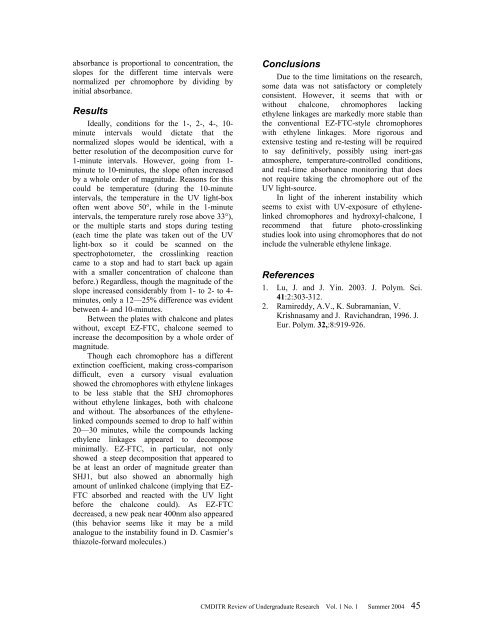CMDITR Review of Undergraduate Research - Pluto - University of ...
CMDITR Review of Undergraduate Research - Pluto - University of ...
CMDITR Review of Undergraduate Research - Pluto - University of ...
Create successful ePaper yourself
Turn your PDF publications into a flip-book with our unique Google optimized e-Paper software.
absorbance is proportional to concentration, the<br />
slopes for the different time intervals were<br />
normalized per chromophore by dividing by<br />
initial absorbance.<br />
Results<br />
Ideally, conditions for the 1-, 2-, 4-, 10-<br />
minute intervals would dictate that the<br />
normalized slopes would be identical, with a<br />
better resolution <strong>of</strong> the decomposition curve for<br />
1-minute intervals. However, going from 1-<br />
minute to 10-minutes, the slope <strong>of</strong>ten increased<br />
by a whole order <strong>of</strong> magnitude. Reasons for this<br />
could be temperature (during the 10-minute<br />
intervals, the temperature in the UV light-box<br />
<strong>of</strong>ten went above 50°, while in the 1-minute<br />
intervals, the temperature rarely rose above 33°),<br />
or the multiple starts and stops during testing<br />
(each time the plate was taken out <strong>of</strong> the UV<br />
light-box so it could be scanned on the<br />
spectrophotometer, the crosslinking reaction<br />
came to a stop and had to start back up again<br />
with a smaller concentration <strong>of</strong> chalcone than<br />
before.) Regardless, though the magnitude <strong>of</strong> the<br />
slope increased considerably from 1- to 2- to 4-<br />
minutes, only a 12—25% difference was evident<br />
between 4- and 10-minutes.<br />
Between the plates with chalcone and plates<br />
without, except EZ-FTC, chalcone seemed to<br />
increase the decomposition by a whole order <strong>of</strong><br />
magnitude.<br />
Though each chromophore has a different<br />
extinction coefficient, making cross-comparison<br />
difficult, even a cursory visual evaluation<br />
showed the chromophores with ethylene linkages<br />
to be less stable that the SHJ chromophores<br />
without ethylene linkages, both with chalcone<br />
and without. The absorbances <strong>of</strong> the ethylenelinked<br />
compounds seemed to drop to half within<br />
20—30 minutes, while the compounds lacking<br />
ethylene linkages appeared to decompose<br />
minimally. EZ-FTC, in particular, not only<br />
showed a steep decomposition that appeared to<br />
be at least an order <strong>of</strong> magnitude greater than<br />
SHJ1, but also showed an abnormally high<br />
amount <strong>of</strong> unlinked chalcone (implying that EZ-<br />
FTC absorbed and reacted with the UV light<br />
before the chalcone could). As EZ-FTC<br />
decreased, a new peak near 400nm also appeared<br />
(this behavior seems like it may be a mild<br />
analogue to the instability found in D. Casmier’s<br />
thiazole-forward molecules.)<br />
Conclusions<br />
Due to the time limitations on the research,<br />
some data was not satisfactory or completely<br />
consistent. However, it seems that with or<br />
without chalcone, chromophores lacking<br />
ethylene linkages are markedly more stable than<br />
the conventional EZ-FTC-style chromophores<br />
with ethylene linkages. More rigorous and<br />
extensive testing and re-testing will be required<br />
to say definitively, possibly using inert-gas<br />
atmosphere, temperature-controlled conditions,<br />
and real-time absorbance monitoring that does<br />
not require taking the chromophore out <strong>of</strong> the<br />
UV light-source.<br />
In light <strong>of</strong> the inherent instability which<br />
seems to exist with UV-exposure <strong>of</strong> ethylenelinked<br />
chromophores and hydroxyl-chalcone, I<br />
recommend that future photo-crosslinking<br />
studies look into using chromophores that do not<br />
include the vulnerable ethylene linkage.<br />
References<br />
1. Lu, J. and J. Yin. 2003. J. Polym. Sci.<br />
41:2:303-312.<br />
2. Ramireddy, A.V., K. Subramanian, V.<br />
Krishnasamy and J. Ravichandran, 1996. J.<br />
Eur. Polym. 32,:8:919-926.<br />
<strong>CMDITR</strong> <strong>Review</strong> <strong>of</strong> <strong>Undergraduate</strong> <strong>Research</strong> Vol. 1 No. 1 Summer 2004 45




